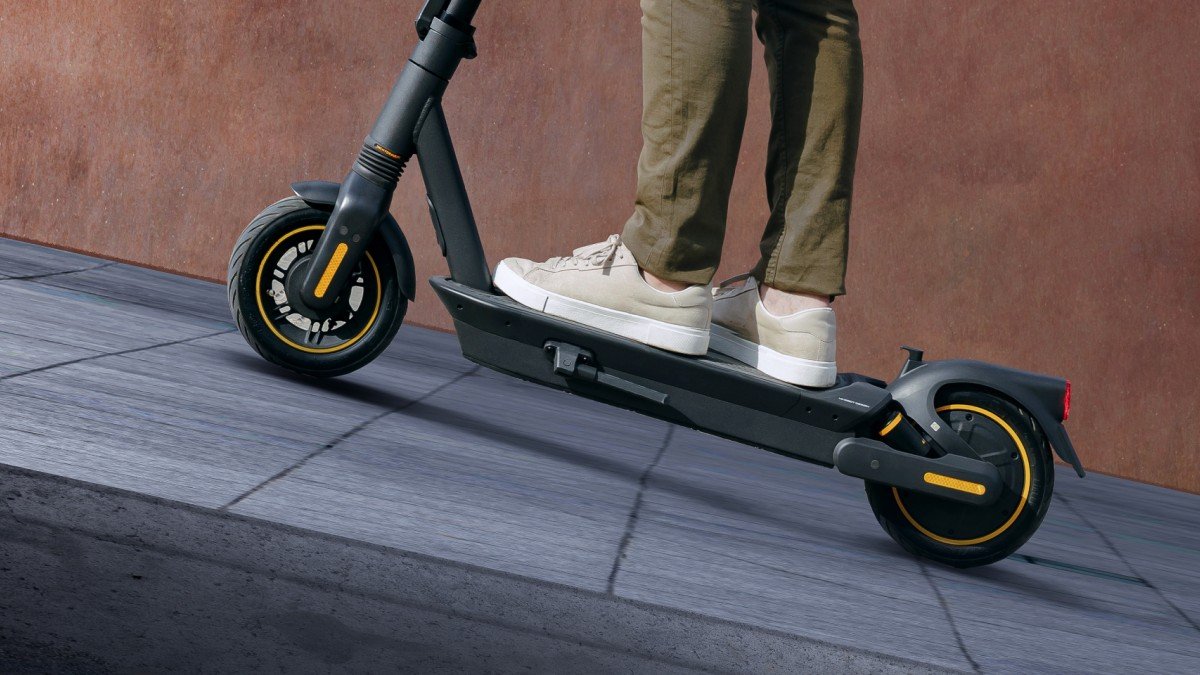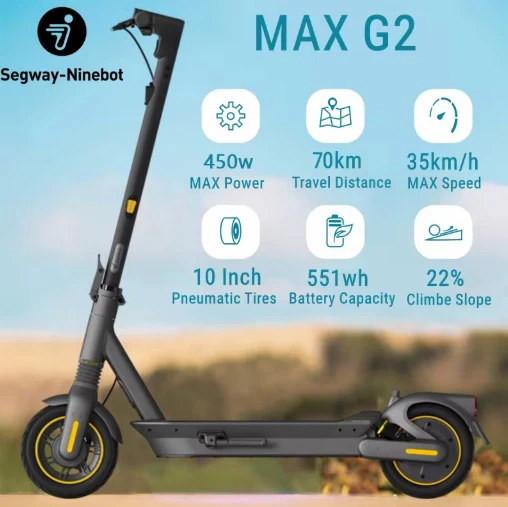
Video Review
Written Review
The Segway Max G2 is an evolution of the hugely popular Max series, known for long range and durability. The Max G2 specifically stands out for having impressive range (up to ~43 miles) and the addition of suspension (albeit minimal), a feature the original Max lacked entirely. It has a beefy 551 Wh battery, a 450 W rear motor, and 10-inch self-healing tires and turn signals. Weighing about 53 lbs, it’s certainly not the lightest commuter scooter, but it is built for durability and reliability above all else.
Click here for the latest price of the Segway Max G2.

Q: What is the max speed of the Segway Max G2?
A: By factory settings, the Max G2 is limited to 15.5 mph (25 km/h) to comply with regulations. This is the official top speed out of the box. However, the G2 can be unlocked to around 20–22 mph via the app or using a “speed unlock” cable (some markets, like Australia, sell a kit to unlock ~35 km/h). In North America, Segway sometimes allows ~18 mph on the Max series. Regardless, its powerful motor means it holds the electronically limited top speed very well even up mild hills.
Q: What is the range of the Segway Max G2?
A: Segway advertises up to 70 km (about 43–44 miles) of range on the Max G2 in ideal conditions. This assumes a lower-speed mode (Eco ~9 mph) on flat terrain. In unlocked mode at full 20 mph, the range is more around 40–50 km (25–31 miles) on a full charge, but we would still adjust that estimate downwards. In everyday riding, we'd bet most users will see somewhere in the 20–25 mile range per charge.
Other factors that impact range are rider weight, ambient temperature (hotter is better), and overall battery health. We recommend doing a full range test in your specific conditions before trusting it as a commuter for ranges in the upper bounds of 20-25 miles.
Q: What is the battery size of the Segway Max G2?
A: The Max G2 comes with a 551 Wh lithium-ion battery (which is 15.3 Ah at 36 V). The battery is built into the deck and uses Segway’s smart Battery Management System to monitor health and safety. For comparison, the original Max (G30) had ~551 Wh as well; the G2 uses its battery capacity more efficiently with improved controllers (Segway markets a “RideyLONG” technology to optimize range).
Q: Does the Segway Max G2 have a removable battery?
A: No. The battery in the Max G2 is internal and not designed to be removed by the user. The scooter’s deck houses the battery (which helps with the low center of gravity for stability). Unlike some e-bikes or a few scooters with swappable batteries, the Max series does not have a quick-swap battery feature.
Q: How long does it take to charge the Segway Max G2?
A: Thanks to a built-in 3A fast charger (the large box that usually comes on a standard scooter charger is actually contained within the deck of the scooter), the Max G2 reaches full charge in about 6 hours. This is reasonable given the large 551 Wh battery.
Q: What is the weight of the Segway Max G2?
A: The Max G2 weighs about 24.3 kg, which is roughly 53.5 lbs. It’s a hefty scooter – notably heavier than the F series or ES series. This weight comes from the large battery, the sturdy frame, and the addition of suspension components. While 53 lbs is still decently portable for short periods (lifting up a curb or into a trunk), it’s not something you’d want to carry for long. The benefit of that weight is a very solid ride feel and stability at speed.
Q: What is the weight limit of the Segway Max G2?
A: The Max G2 can support up to 120 kg (265 lbs) of rider weight. This is an improvement over older Max models which were around 100 kg.
Q: Is the Segway Max G2 single or dual motor?
A: The Max G2 uses a single motor, located in the rear wheel. It’s a rear-wheel-drive 450 W nominal motor with about 1000 W peak output (very impressive for a commuter scooter). This setup is similar to the original Max (which was front-wheel 350W) but the G2 switches to rear drive for better traction during acceleration.
I personally much prefer single motor scooters to have the motor in the rear rather than the front. I own a Hover-1 Journey 2.0 scooter that I use for short commutes, and it bugs me that every time I accelerate from a stop (unless I am consciously leaning forward), the front wheel loses traction and skids for a couple feet, gradually eroding the tire tread over time.
Q: How big are the tires on the Segway Max G2?
A: It features 10-inch tubeless pneumatic tires, the same size as the original Max series. These are self-healing tires, meaning they have a jelly/sealant layer to automatically fix small punctures (so you’re less likely to get a flat tire). The tires are about 2.5 inches wide, providing good stability and shock absorption especially combined with the new suspension.
10-inch tires are a sweet spot for commuter scooters, in my opinion - they roll over bumps better than 8-inch ones (like on the ES2) but don’t add too much bulk.
Q: What are the brakes on the Segway Max G2?
A: The Max G2 uses a combination of a front drum brake and a rear electronic brake. The front wheel has a drum brake enclosed within the hub – drum brakes are low-maintenance and work well in wet conditions (plus no exposed disc to bend). However, speaking from experience maintaining scooters, drum brakes are tougher to fix the rare times that they do have issues. Traditional disc brakes are easy to tune up without dismantling the wheel/hub. Not so with drum brakes.
Q: Is the Segway Max G2 foldable?
A: Yes, the Max G2 has a folding stem design, similar to all Segway scooters. There’s a latch at the base of the handlebar stem that you unlock, allowing the stem to fold down and hook onto the rear fender (there’s a little latch hook on the fender). This folded position makes it easier to carry or roll the scooter. Keep in mind, at 53 lbs, “portability” is relative – it folds for convenience, but it’s a bit heavy to carry long distances.
Q: Can the Segway Max G2 climb hills?
A: Yes, the Max G2 is quite capable on hills for a single-motor scooter. It’s rated to handle up to 22% inclines (about 12.5° grade). In real-world terms, it will climb typical city hills without losing too much speed.
Q: Does the Segway Max G2 have suspension?
A: Yes, and this is an important upgrade - the Max G2 has a front hydraulic suspension and a rear dual-spring suspension. This dual suspension setup markedly improves ride comfort compared to the old solid-frame Max.
Q: Can you ride a Segway Max G2 in the rain?
A: Yes, the Max G2 has an IPX5 water-resistance rating, which means it’s designed to withstand splashes and light rain. Drum brakes work well even when wet, and the Max G2 has built-in front and rear lights and turn signals for visibility in low-light or rainy conditions.
Never charge the scooter when it has been in the rain, or when any components (including the charger itself) are wet.
Q: Does the Segway Max G2 have an app?
A: Yes. The Max G2 works with the Segway-Ninebot app (the same app as other Segway scooters). Through the app, you can monitor your ride statistics in real time, adjust settings, lock the scooter, and even enable features like “Follow Mode” (if you want to walk alongside the scooter while it powers its wheels slowly). The app is also where you set up the AirLock phone-as-key feature and pair the scooter with Apple Find My. It will also alert you of any firmware updates.
Q: What is an alternative to the Segway Max G2?
A: Alternatives to the Max G2 would be other long-range commuter scooters. A popular one is the Apollo City Pro, which offers about 38 mile range and dual suspension, but it has dual motors and is pricier. Another is the NIU KQi3 Max, which has similar range (~40 miles) and around 23 mph top speed, though it doesn't have suspension like the Max G2. If you’re looking at pure range, the EMOVE Cruiser is another popular alternative with ~62 mile max range (at a similar price point), albeit with a different design (it has suspension and 52 V battery, but also weighs ~52 lbs).
The Freshly Charged Take: The Segway Max G2, by adding suspension and other upgrades to the proven Max formula, is a great premium commuter option. It’s not lightweight or very budget-friendly scooter, but if you're willing to make the investment, it should last for a long time.
More Segway Reviews from Freshly Charged
Looking for more Segway content? Check out our in-depth reviews across every category:
Commuter Scooters
- Segway F2 Pro Review
- Segway F3 Review
- Segway F3 Pro Review
- Segway F65 Review
- Segway D28 Review
- Segway E2 Plus Review
- Segway E2 Pro Review
- Segway Ninebot Max G30LP Review
- Segway Max G2 Review
- Segway Max G3 Review
- Segway Air T15 Review
- Segway ES2 Review
- Segway ES3 Review
- Segway ES4 Review
High-Performance Scooters
- Segway GT1 Review
- Segway GT2 Review
- Segway GT3 Review
- Segway GT3 Pro Preview
- Segway ST1 Announcement
- Segway ZT3 Pro Review
Kids & Youth Scooters
Go-Karts
Bikes
Other Vehicles
Scooter Comparison Tool
Use our Freshly Charged Scooter Comparison Tool to evaluate this scooter alongside more than 500 other scooters. Compare and organize scooters by factors such as price, top speed, battery size, weight, water-resistance rating, and more!
No comments yet…